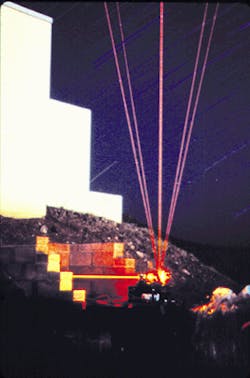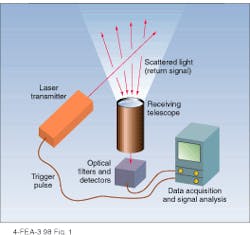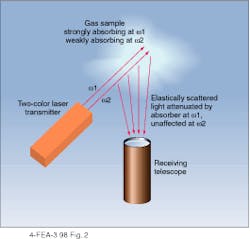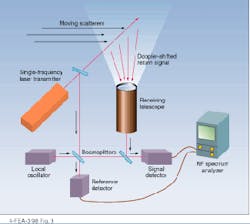Scattering and/or absorption of laser light by atmospheric constituents is the basis for a family of remote-sensing techniques that allow the measurement of important environmental parameters on both a local and global scale. From the early detection of chemical or biological warfare agents to the mapping of global wind velocities, lidar (light detection and ranging) systems offer unique advantages with respect to sensitivity, selectivity, and accuracy. As a result, they provide a market for existing laser systems in addition to providing an impetus for the development of new ones.
The term lidar typically describes remote-sensing systems having the basic architecture shown in Fig. 1. In this setup, the output of a modulated laser transmitter is collimated and aimed at the region of interest. As the beam interacts with the atmosphere, distributed scattering and/or fluorescence produce a return signal that is collected by a receiving telescope. Range information is extracted by correlating the return signal with the modulated transmitter in a data-acquisition module that usually converts the raw data to a more usable form.While differences in range, transmitter spectrum, and modulation format lead to a large number of different designs, lidar systems are commonly classified according to the source of the return signal. With laser-induced fluorescence (LIF), the transmitter is tuned to a strong absorption and the return signal generated by fluorescent decay. In contrast, both DIAL (differential absorption lidar) and Doppler systems look at light that is scattered elastically by atmospheric aerosols. DIAL systems measure molecular concentrations by comparing the scattered light at different wavelengths corresponding to local minima and maxima in the absorption spectrum. In contrast, Doppler lidar systems typically operate in atmospheric transmission windows, using the frequency shift of the return beam relative to the laser transmitter to determine the velocity of the scatterer.
DIALing molecular concentrations
Widely used for the measurement of absorbing atmospheric constituents, differential-absorption-lidar (DIAL) systems measure the attenuation of elastically scattered light. A typical DIAL system operates at two wavelengths—one that is matched to a strong absorption line and one that is comparatively unattenuated by the compound of interest (see Fig. 2). Assuming the transmitter power and elastic scattering coefficients at the two wavelengths are equal, the difference in the power collected by the receiving telescope is directly related to the density of the absorbing species.In a typical DIAL application, the concentration of silicon dioxide (SO2) in the stack emission of a manufacturing plant is measured by a transmitter with output wavelengths of 300 and 299.3 nm. The SO2 absorption spectrum in this region indicates that the 300-nm wavelength corresponds to a large absorption peak with a cross section of 125 10-24 m2, while the 299.3-nm minimum has a cross section of only 25 10-24 m2. In operation, measurements are relatively unaffected by atmospheric particulates such as soot.
Because the strongest molecular absorption bands are usually found in the ultraviolet or mid-infrared, DIAL systems are often designed to operate in these spectral regions. For example, SO2, nitric oxide (NO), ozone (O3), and mercury (Hg) have been measured with UV systems operating near 300 nm, while mid-infrared systems have been used for carbon monoxide (CO), hydrogen fluoride (HF), and methane (CH4). Q-switched laser-output energies in the 10–200-mJ range are typically required, making the design of the laser transmitter a formidable task.
Doppler lidars map wind velocities
In contrast to DIAL systems in which information is obtained from the amplitude attenuation of the backscattered beam, Doppler techniques look at the frequency shift. According to the principles of basic physics, light scattered from a moving object is shifted in frequency relative to an incident beam by an amount that is determined by the velocity vector of the scatterer. In the system of Fig. 3, optical heterodyning is used to measure the frequency shift of the scattered return relative to the transmitter. By mixing the output of a stable, single-frequency local oscillator with the transmitted and return signals in an optical detector, radio-frequency beat notes are produced. Assuming the frequency of the local oscillator to be constant, the Doppler shift in the return frequency is equal to the difference between the transmitter and return-signal beat notes.While this technique has been used to look at a wide range of physical phenomena, one of the most interesting applications is the measurement of wind velocities. In the aviation industry, for example, compact Doppler lidar systems on operating aircraft detect dangerous turbulence early enough for the pilot to avoid it. Alternatively, low-power lidar systems placed at intervals along a runway can provide “wake avoidance” in busy airports.
On a larger scale, NASA has a strong interest in orbiting an eye-safe Doppler system in space that could map global wind velocity. Such a system, based on a diode-pumped, eye-safe solid-state laser, would aid in monitoring and predicting global weather patterns. Plans currently exist to fly a system on the Space Shuttle in the not-too-distant future to demonstrate feasibility, with full-scale satellite deployment to follow (see Laser Focus World, March 1998, p. 28).
Probing the outer atmosphere with LIF
In contrast to DIAL and Doppler techniques in which the return signal is produced by elastic scattering of the transmitted light, the receiver in a LIF lidar system looks at fluorescent emission. Under conditions where radiative de-excitation is the dominant decay mechanism, the absorption of light from the lidar transmitter is rapidly followed by spontaneous emission at a longer wavelength. In a typical case, the emission is red-shifted by several tens of nanometers, and filters in the receiver separate the fluorescent return from the elastically scattered excitation beam. To efficiently excite the species of interest, the transmitter wavelength must be locked to the peak of a strong absorption. As with other systems, range information is obtained by modulating the transmitter and gating of the data-acquisition electronics.
A primary application of this technique is for detection and mapping of specific compounds in both the liquid and gas phases. For example, LIF systems operating at ultraviolet wavelengths are currently being developed for the long-range detection of biological and chemical toxins on the battlefield. In a typical scenario, an LIF lidar system, capable of detecting proteins that are common to most biological warfare agents, would warn ground troops of an impending threat.
In a more germane environmental sensing application of the LIF technique, the University of Illinois (Champaign-Urbana, IL) sodium lidar has measured temperature and velocity profiles in the upper atmosphere (see photo at top of this page). By carefully scanning the transmitter wavelength across the D2 sodium line, Doppler broadened line shapes were recorded, making it possible to extract information on wind velocity and temperature.
Long-range lidars push laser technology
Historically, remote-sensing applications have been the driving force behind the development of many new lasers and nonlinear frequency-conversion techniques. Delivering 10 to 100 mJ of Q-switched power at the specific wavelength(s) required for a particular sensing application is a formidable task that requires careful attention to both materials selection and optomechanical design.
In both the LIF and DIAL techniques, it is necessary to match the transmitter wavelength to a strong absorption line. While fortuitous matches exist between the emission of a rare-earth-doped materials such as Nd:YAG or Ho:YLF and a species of interest, they are not common, and a tunable transmitter is typically required. Although dye lasers have often been used for sensing applications, solid-state crystals such as alexandrite, Ti:sapphire, and the cesium-doped colquirites (Ce:LiSAF and Ce:LiCAF) have significant advantages with respect to lifetime and ease of use.
Nonlinear conversion techniques can also produce a tunable output directly from a fixed frequency source. For example, a mid-IR optical parametric oscillator (OPO) pumped by a single-frequency, Q-switched Nd:YAG laser at 1064 nm can generate wavelengths throughout the near- and mid-infrared. Although limited by material problems for many years, these devices are currently entering the mainstream due to the commercial availability of periodically poled lithium niobate and other crystals that combine high nonlinearity with good damage properties and transparency. At shorter wavelengths, OPOs based on potassium titanyl phosphate (KTP), periodically poled lithium niobate (PPLN), lithium triborate (LBO), or beta barium borate (BBO) can be pumped by a harmonic of the 1064-nm Nd:YAG laser, providing tunable output in the ultraviolet and visible spectral regions.
Diode-pumping techniques and, in some cases, the diodes themselves are also of major importance for remote-sensing applications. In theory, diode-pumping offers significant improvements in frequency stability, efficiency, and lifetime when compared to other techniques. Injection-locking, which allows the output of a high-power, Q-switched laser to be controlled by a highly stable, diode-pumped solid-state laser or single-frequency diode laser, is commonly used to control the output of lidar transmitters. In fact, injection seeding of the flashlamp-pumped, 1064-nm Nd:YAG laser was one of the first commercial applications of diode-pumped laser technology.
At higher powers, diode-bar pumping offers significant improvements in efficiency and lifetime over conventional techniques but has found limited practical application. Because the pulsed output from a diode array is, at best, only a few times larger than its continuous-wave output, it takes a large number of diodes to generate the output energy of a small flashlamp. As a result, the diode alternative is far too expensive for most practical applications.
Because of the importance of environmental remote sensing to our understanding of atmospheric chemistry and weather, it is reasonable to expect a continued interest in source development. Due to their cost and complexity, high-power, long-range systems will be supported almost exclusively by governmental agencies such as NASA and the National Oceanic and Atmospheric Administration. Shorter-range systems, however, are currently being developed by industry for applications in industrial process monitoring, personnel protection, and wind sensing. Continued progress in the semiconductor laser field will aid in the development of these systems.
FURTHER READING
R. M. Measures, Laser Remote Sensing, Fundamentals and Applications, John Wiley, New York, NY (1984).
U. N. Singh, “Lidar for Atmospheric Remote Sensing,” Optical Measurement Techniques and Applications, P. K. Rostogi, ed., Artech House, Boston, MA (1997).
S. Svanberg, Atomic and Molecular Spectroscopy – Basic Aspects and Practical Applications, Springer-Verlag, Berlin (1991).



